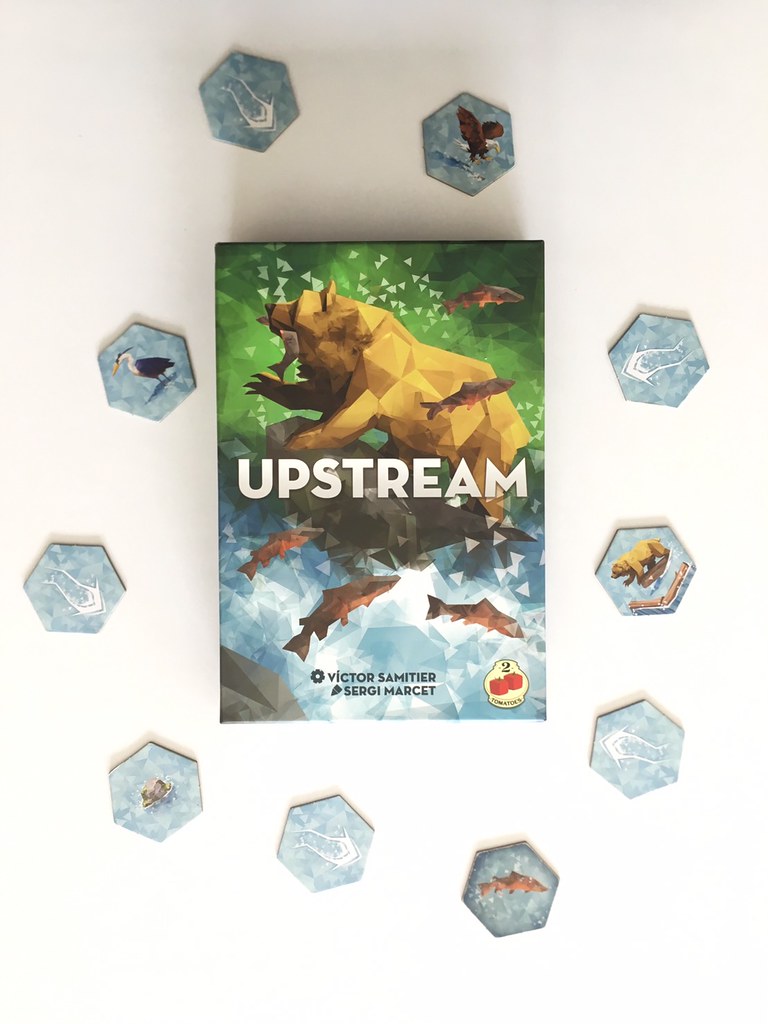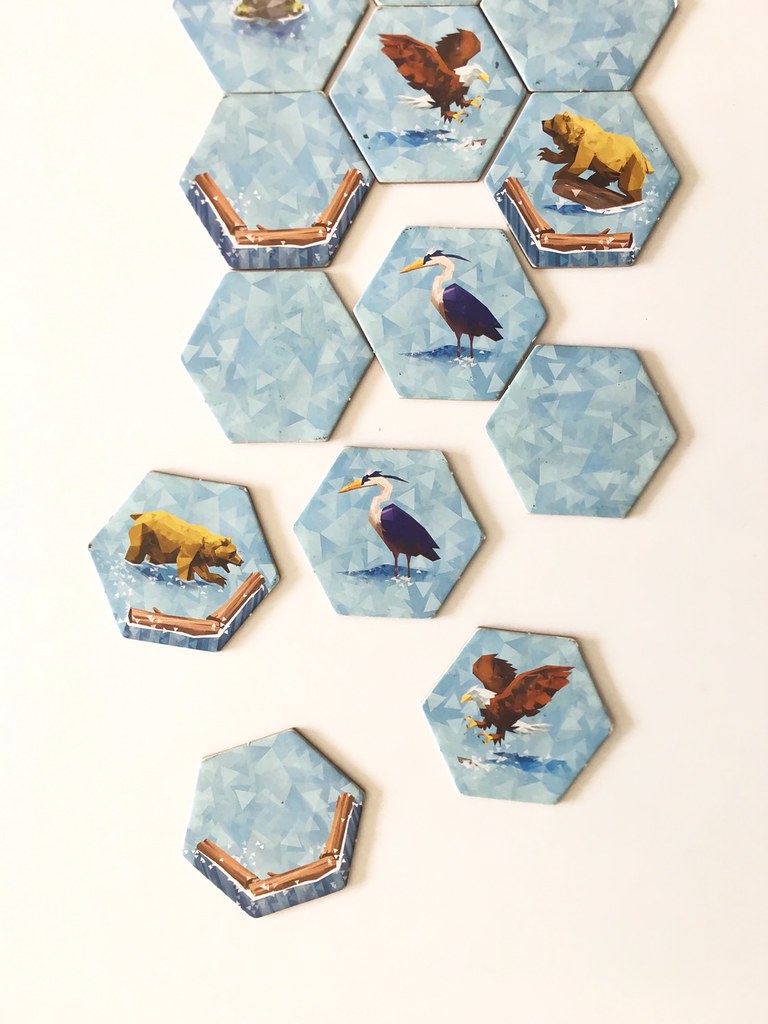I always love board games like Upstream that sound up ecology and environment with its theme, knowing how important and crucial it is this day. Well, there’s a bunch of publishers and designers who have designed and published games bringing up this topic recently and I am interested in one of them during the Spiel Essen 2018: Upstream from 2 Tomatoes Games. You can read our encounter with this publisher and their games here.
The story behind Upstream
Upstream is a board game for 2-5 players. It needs approximately 20-30 minutes to play. Victor Samitier designed the board game and Sergi Marcet is responsible for the artwork.
Have you ever heard about the salmon run? It’s a beautiful life cycle from the most favourite fish on your dining table; Victor had this fresh idea for Upstream coming after he watched a documentary about this natural phenomenon. The salmons will migrate from the ocean to the riverbed, going upstream and evading predators to spawn their new generations. You can find it here. You can now immerse yourself in their long, dangerous journey in Upstream.
So why the Salmon run? ‘It has every element to build a game: the tensed race, the conflict between salmons and the predators, and the obstacle,’ Victor replied.
The artwork is really unique and quite interesting. I am not really an expert in art style, so I asked Sergi and he kindly provided the answer although he’s busy with his other job. He tried to convey the simplicity of the game through the artwork.
In addition, he illustrated it so it is easy to read but still colourful to reinforce the nature theme. ‘It should stand out among the crowd of similar games out there,’ he said.
While making the artwork, Sergi found the inspiration from indie video games and then he added his own spin. ‘It was a bit tricky but I am happy with the result.’ So do we, Sergi, you have done a great job!
Set up the Upstream game
This normal rule below is for the game with at least 3 players. The rule for 2 players has been tweaked a bit from the normal rule to adapt the number of players in order to make it more balanced. To play the game, first set up the 4 ocean tiles as the starting point and shuffle the rest of the tile to make a stack. Each player then draw 1 tile and arrange it until there are 3 rows with 3 tile each. These tiles are the first path of the river the salmons will face.
Each player then takes all 4 salmon tokens and put it on each ocean tile; there are 2 faces on the token with 1 and 2 salmons. In the beginning, flip the 2 salmons up. The game can now begin. Starting from the first player, on each turn per round, each player must spend all of his or her 5 movement points. Please be aware that the salmons can only move upstream; downstream moves are illegal.
Playing Upstream
Moving one salmon token (regardless it’s 1 or 2) costs 1 movement point; jumping costs 1 movement point plus 1 point per jumped tile. Jumping is necessary when there’s an obstacle ahead. This obstacle comes from the tile or when the capacity on 1 tile is full; it is considered full when the number of tokens on it is equal to the number of players.
Several tiles deliver predators: eagles, bears, and blue herons. These predators are triggered differently. Eagle tile is triggered automatically when a salmon token passes the tile and it will then fly away; the tile is then flipped down and it is safe to pass it now. The bears are only interested in salmon tokens that jump; if you just swim to pass it, it does not do any harm. Meanwhile, the blue herons are the most friendly of them all; it will only catch one salmon (not salmon token) that stays there at the end of each turn.
When the round is over, remove the last 3 tiles from the game and place new 3 tiles ahead; if there’s a salmon token on these tiles, then it is removed as well. Be careful not to get late! The first player can alter the position and the orientation of the tiles. Pass the first player token to the next one on the left and proceed with the game. Please mind that the tiles are not removed on your first round.
When there are only two tiles left on the stack, flip and rearrange the ocean tiles; it will be the finish line: the riverbed. You can see the salmon eggs arranged from 1 to 5 on each tile. Whenever a salmon token gets on the first tile with 1 egg, it will stay there and will not move until the next round commences. This tile has the same capacity rule as the other normal tile. When the next round has commenced, the salmon tokens on these tiles will move forward one space to a tile with more eggs on it. Do this until every token has arrived on these tiles or washed away by the river.
End of game and scoring
The game ends when there’s no more token left to enter the riverbed token; the players can now calculate the points they have scored. Each remaining salmon on the token contributes 1 point; each remaining salmon token is multiplied by the number of eggs on the tile it stands on. The player who scores most points wins the game. The tie-breakers are the most remaining salmon, then the most remaining salmon tokens, and then the last is the furthest token upstream.
My experience and opinion about Upstream
Two words: fun and competitive. The game is pretty straight forward and really easy to understand. You manage 5 movement points to move forward while trying not to lose too many salmons as well. The modular board increases the replayability of this game. This game is more strategical than it looks, to be honest. You have initially 8 salmons and trust me, you will lose some in this game; trying to get them all reaching the riverbed is futile. I think that’s actually pretty much the same in nature, not all salmons will survive reaching the spawning area.
There are so many predators out there and I think everyone will always try his or her best to evade the eagles; you still have a ‘backdoor’ to get through the bear and the blue heron safely, but not with the eagle. I like the idea of eliminating the last three tiles on the back because it gives more challenges for the players.
The game has different rules for 2 players but there’s no significant difference in the setup. The gameplay for each player count needs similar strategy. I enjoyed the game with 4 players and do not recommend 5 players game because it was too crowded. You can still play and enjoy Upstream with 3 players, though!
The expansion is also a fun set to play. I recommend using the expansions Rapid tiles and the Whirlpool tokens after you know the basic rules of Upstream. It gives more depth and variety of what could happen to the game. Upstream is really good for an introductory game to new players. I would recommend to play it with your new pals on the table. This game, however, might not be interesting for those who despise randomness and do not like the kind of racing games.
The mechanism is grid movement with action point as the core. Artwork-wise, I really love the illustration from Sergi Marcet. I would say it would be good if we have more safe water tiles; it’s hard for the salmon to get horny if they face too much stress from the predators and obstacles! LOL.
Currently Victor is developing on other projects; one of them will be a 2-player-game that belongs to abstract game category that will involve dice drafting with the five Chinese elements as the theme. I am really excited to wait for your next project! Thank you 2 Tomatoes Games for your faith on us to review your games. I wish you guys well and really look forward to your next project. Thanks a lot for the crews at Invaders Board Game Station who helped us with the gameplay of Upstream on their table.
I am a full-time food technologist during weekdays. However, when the calendar hits weekends, I transform into an avid board gamer. I am a hardcore Legend of the Five Rings (L5R) LCG player from Fantasy Flight Games (FFG). Current hobby: buying board games. My shelf of shame’s list is getting longer, thanks to you, Kickstarter.









